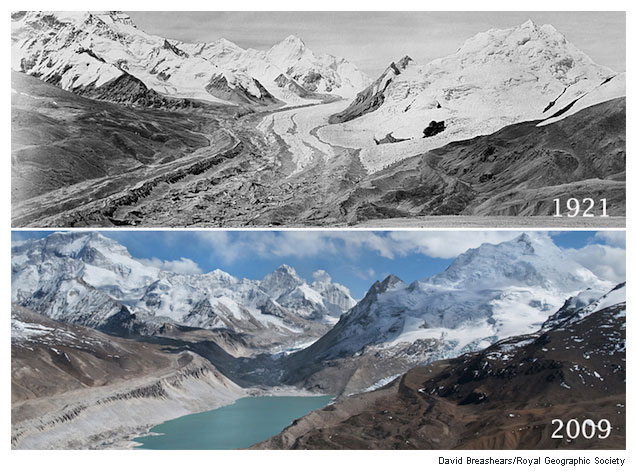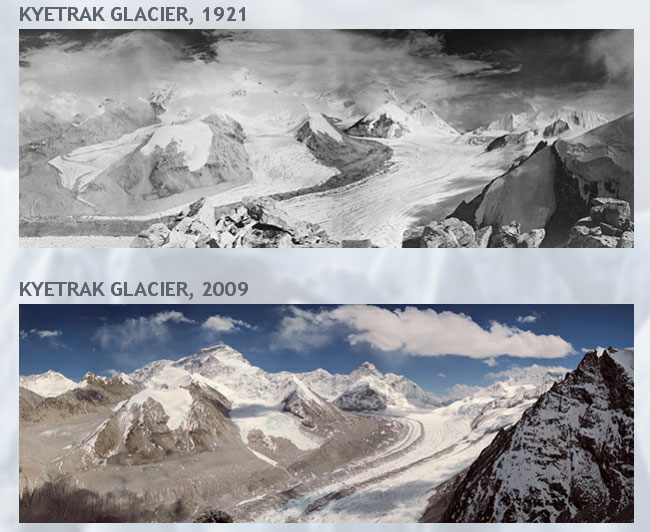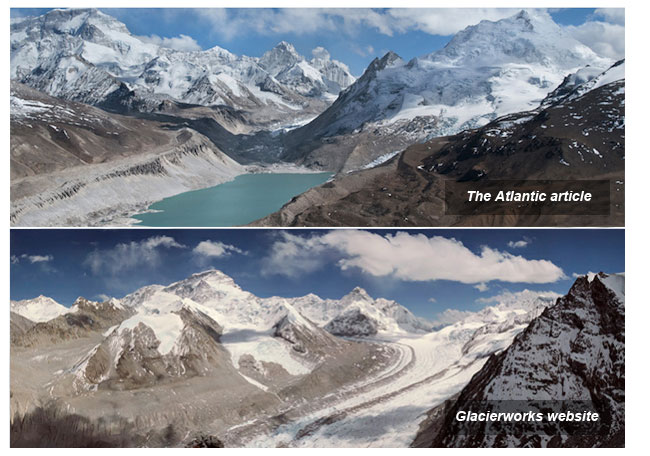Climate change and why not every picture tells the true story
“Believe nothing, no matter where you read it, or who said it … unless it agrees with your own reason and your own common sense.” Buddha.
I’m no climate change sceptic, and I’ve seen its effect on shrinking glaciers many times. The Alps are full of U-shaped valleys where it’s clear the ice has retreated fairly recently, leaving behind a bare rock surface which hasn’t had time to become populated with plants. I once read a guide book about climbing routes in the Rwenzori Mountains, Uganda, which was originally written in 1972. I had the second edition of the book, written 30 years later, and a whole chapter was dedicated to how much the routes had changed from ice to rock in that relatively short period. Most recently I was in Colombia, where a national park warden told me they were measuring speeds of glacier retreat as high as 20 metres a year. And if I didn’t believe him I saw it with my own eyes. Time after time I found myself scrambling over smooth slabs of rock which extended well beneath the vegetation line. In places small plants had started inhabiting cracks in the rock, but mostly they were bare. Only a glacier could have done this to them. I was shocked by what I saw, and wrote a post about it called Colombia’s glaciers will soon be gone, estimating “soon” to be only about 30 years.
While scientific evidence for climate change is no longer in doubt, not everyone is convinced it’s happening. One of the most powerful methods being used to convince sceptics is photography. When two pictures are put side by side showing how much glacier has disappeared over the period of a few decades, who can deny it then? Take the following example which appeared in the American cultural magazine The Atlantic last week under the heading Can This Photograph of a Himalayan Glacier Persuade People That Climate Change Is Happening?.

The photograph purports to show two views of Everest and the Rongbuk Glacier taken in 1921 and 2009. The photographer of the modern photo, David Breashears, is quoted as saying:
“It showed the ice-encrusted north face of Everest and, below it, the great river of ice known as the Main Rongbuk Glacier … Eighty-six years after [George] Mallory took that photograph, I sat in the exact spot where he had snapped his iconic picture. Pulling out his photo, I was stunned by the changes that had swept over this region. The wide river of ice had retreated more than half a mile, leaving a field of separated ice pinnacles melting into the rocky ground.”
When I first read the article, I had no doubt David Breashears had witnessed a classic example of climate change in action, and that the glacier really had shrunk that far since George Mallory’s day. What I was more sceptical about was whether it was actually Everest in the photo, as you can see from what I posted on Twitter after I read it.
Can this photo of Everest persuade people of climate change? http://t.co/UPzblAe8 Can’t work out where this is taken from – v unusual angle
— Mark Horrell (@markhorrell) June 28, 2012
The thing is, I walked up and down the Rongbuk Glacier half a dozen times a little over a month ago, and it looked like no view of Everest I can remember seeing. But mountains can look very different depending on what angle you look at them from, and I was curious. I posted to my Facebook page asking if anyone could tell me where the picture might have been taken from. Somebody suggested it might be Makalu from the Kharta Glacier, and not Everest from the Rongbuk Glacier, as stated in the article. Another climbing friend pointed out the photo had been taken by David Breashears – so why didn’t I ask him?
Yeah, that’s going to work, I thought to myself. David Breashears is a very well known mountaineer and film maker, perhaps best known for directing the Everest IMAX movie, but who also worked on the Hollywood blockbusters Cliffhanger with Sylvester Stallone and Seven Years in Tibet with Brad Pitt. It’s not as though I can just pick up the phone and give him a tinkle!
But my friend was right. There was a way I could contact him and get an answer really quite quickly. Here’s what appeared in my Twitter timeline later that day.
We’re on Pinterest! RT @KQEDscience: The same view of Mount Everest, 88 years apart, affords a striking contrast http://t.co/1yRpmJJW
— GlacierWorks (@GlacierWorks) June 28, 2012
I clicked on the link in the tweet and found myself looking at the same picture as I’d seen in The Atlantic article. GlacierWorks is the charity set up by David Breashears to document the state of glaciers in the Himalayas by matching historic photographs with how they look today. I first heard about them when they tweeted me while I was at Everest Base Camp in May saying they were at base camp too and were running an exhibition there – why didn’t I come over and have a look? With my interest in old mountaineering literature I would love to have done so, but there was a problem: they were at base camp on the south side and I was on the north. A few thousand metres of mountain, including Everest herself, separated us. But I had an opening. The great beauty of Twitter is that people tend to be very responsive. And so it proved:
@GlacierWorks Ah, that’s your photo. Been having a discussion about where it was taken from, but can’t work it out. Can you confirm please? — Mark Horrell (@markhorrell) June 28, 2012
@markhorrell Good eyes! It’s actually the Kyetrak glacier. http://t.co/MBEuMzzu
— GlacierWorks (@GlacierWorks) June 28, 2012
So there was my answer. It wasn’t Everest and the Rongbuk Glacier at all, but nearby Cho Oyu and the Kyetrak Glacier. The mystery was solved! Or was it. I clicked on the link they’d sent me, and sure enough, although it was a different pair of photographs taken from a slightly different place, it was more or less the same view. It even had Everest in the far left of the photo for good measure to show its location with respect to Cho Oyu, as you can see.

It was the first time I’d been to the GlacierWorks website, and they actually have a really good site, including some clever sliding graphics that you can drag your cursor across to see how the image changes between the historic and present-day versions. I recommend you visit the site and have a look at the sliders yourself – they’re very interesting (don’t do it on an iPad though as they use Flash, so they won’t work). I sat at my laptop playing around with the sliders and comparing the photographs. Yes, they were definitely the same panorama weren’t they. But hang on a minute – something wasn’t quite right!
@GlacierWorks Definitely same mtn skyline but still confused. Foregrounds of two 2009 pics don’t match, eg this one has glacier but no lake? — Mark Horrell (@markhorrell) June 28, 2012
I opened two separate windows and flipped between them. It wasn’t the comparison between the old George Mallory shots and the modern versions that mystified me, but the variation between the two 2009 pictures. Let’s have a look at them more closely.

As you can see, the skyline is the same in both photos, but one of them has a lake and not much glacier, while the other has plenty of glacier but no lake. The top picture is clearly taken from much higher up the valley where the glacier starts swinging round to the right, while the view in the bottom photo is from much further back, but there don’t appear to be any features in the bottom photo that would obscure the lake from view. Another possibility is the lake is seasonal, and the two pictures were taken at different times of year, but although I don’t know much about glaciology the lake looks too big to be formed simply during a period of higher precipitation.
We exchanged some more tweets.
@markhorrell They are taken from different viewpoints – would have to dig deeper for more detailed info, GPS, etc
— GlacierWorks (@GlacierWorks) June 28, 2012
@GlacierWorks Definitely needs investigation — provides ammo to the sceptics if it can’t be explained. Great website, though … — Mark Horrell (@markhorrell) June 28, 2012
@GlacierWorks Love the scrolling before/afters but comparing both look like someone’s photoshopped a lake on, which I’m sure you haven’t 🙂
— Mark Horrell (@markhorrell) June 28, 2012
@markhorrell Nope, no photoshop! We try to match the photographs as best we can. — GlacierWorks (@GlacierWorks) June 28, 2012
If it looks like I was being a bit cheeky, it’s with good reason. Despite the apparent evidence of the photos, I don’t believe the images have been doctored by the GlacierWorks team to give the appearance the glacier is retreating more than it is, and I’m sure there’s an explanation for it. But what this does show is that photographs aren’t always what they seem. If GlacierWorks’ mission is to provide proof of climate change through photography they need to be beyond suspicion, and sceptics have been known to use such flimsy “evidence” of conspiracy to try and undermine the climate change debate in the past. In 2009 computers at the University of East Anglia were hacked and thousands of emails stolen ahead of the Copenhagen Summit on climate change. The hackers claimed the emails provided evidence of research being fabricated, and although the allegations were later proved to be false the controversy, known as Climategate, dominated the summit meeting and derailed the action some of the participants may have taken on climate change.
But there’s another more fundamental reason than this. Many people set up charities for all sorts of different causes every year, not all of them backed up by the same honourable intentions they profess in their mission statements. For example, there are so-called “environmental” expeditions to clean up Everest every year, many of which have little intention of picking up any litter – they are simply using the the tag as an emotive term to get sponsorship for their climb from corporate donors eager to demonstrate their environmental credentials.
Truth and honesty is what sets the decent charities apart from the charlatans. I believe GlacierWorks are a decent organisation, and I’m fascinated by the way they’re tackling an issue close to my heart in an innovative and engaging way. But photographs are so easy to doctor and charlatans get everywhere. Some day someone will try to use one to get funding for an expedition, in the same way many climbers already make false summit claims to get sponsorship. While photos can be powerful, they’re not always what they seem. Couple this with a journalist’s unfortunate tendency to deceive (such as The Atlantic quoting lines about Everest alongside a photo of Cho Oyu), and some day a climate change sceptic will try to use a photo which looks suspicious to undermine the debate.
Perhaps the photo is real, but if it looks doctored then it lessens its effectiveness. One thing’s for sure, though. I’m mystified and I need a second opinion. What do you think? Does the photo look doctored, is there a simple explanation for the mysterious vanishing lake, or is this much ado about nothing? You can vote in the panel to the right or comment below.






Google Earth to the rescue! http://imgur.com/a/ACgL2
The GlacierWorks shot is much higher up the valley: the Nangpa La is actually clearly visible.
Interesting post, though; I entirely agree: charities like GlacierWorks risk being undermined if they don’t hold themselves to very high standards. Thankfully, they seem to be doing just that.
Andy
Well done, Andy – that’s pretty conclusive! 🙂
I guess you saw this, but GlacierWorks have posted a response to this question here:
http://glacierworks.tumblr.com/post/26786132907/details-the-kyetrak-glacier
Thanks, David. I noticed they have a Tumblr site and bookmarked it, meaning to read it later – hadn’t spotted the subject of the post. My doubts about the photos were pretty much answered by Andy’s Google Earth images above, but it’s nice that GlacierWorks are responsive in this way!